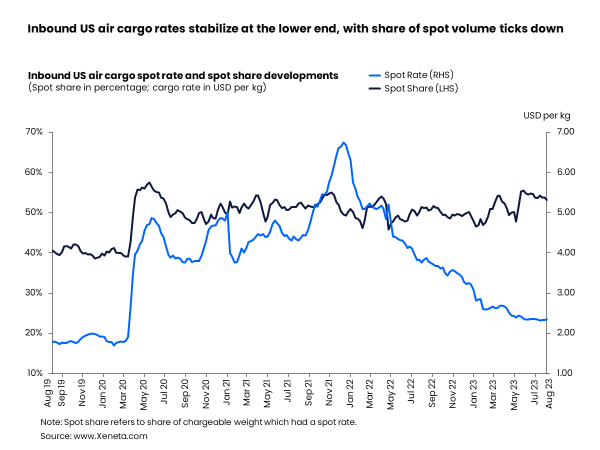Spot rates for inbound US air cargo in the first week of August confirms what Xeneta data has shown over the summer; that global spot rates are gradually stabilizing after falling consistently since early 2022 (the inbound US spot rate has dropped 65% since its peak in December 2021).
Freight forwarders allocated 53% of their inbound volumes to the spot market, down from a peak of 56% in May. This is in line with what has been observed on the shipper side. With spot rates flattening out in recent weeks, freight forwarders are changing course, moving away from spot speculation to securing longer-term rates at the lower end.

The spot-rate stabilization seems partially driven by the pick-up of inbound US cargo volumes, which notched up 5% in the first week of August versus the same period a month earlier.
US economy in for softer landing than expected
Adding to this market trend is the resilience of the US economy, which may experience something of a soft rather than hard landing, with few indicators of recession flying around in recent weeks.
You can find this optimism in the US personal income stats. Real disposable income registered its sixth consecutive increase in June, rising 4.7% year on year, the biggest jump since April 2021. This is attributed to the near 60-year-low unemployment rate and the Fed’s success in easing US inflation.
In line with this, advanced retail sales from the US rose (not seasonally adjusted) 1.4% in July year on year, up from 0.5% in the previous month – which underscores the economy’s resilience as the US personal consumption expenditure account for around two-thirds of the country’s GDP.
Another positive demand indicator (and a barometer of economic growth) is personal consumption expenditure on durable goods, which climbed 4.7% in June year on year, the highest figure since March 2022.
Nevertheless, a full rebound in air cargo volumes is nowhere in sight. The (not seasonally adjusted) retail inventories to sales ratio rose to 1.27 in June, still higher than 1.21 in June 2022 and 1.08 in June 2021 – indicating that the time needed to sell inventories continued to be longer than in the past two years. This is mainly caused by retail inventories rising by a greater extent of 5.6% year on year in June, while the retail sales ticked up only 0.5% year on year, pushing the eventual ratio increase. The ratio averaged at 1.47 in 2018-2019.
Longer-term deals should ease peak-season pain
Looking ahead, high interest rates and inflation will continue to be a thorn in the side of the US economy, with consumers facing higher borrowing costs from banks and constraining household budgets. But in the short term, the robust labor market will support a soft landing, as already stated.
Consequently, this year’s peak season looks set to be a mild one for the inbound US market, as most of the downside triggered by the overheating economy has eased off. The market today is more in line with 2018-2019 levels and off the elevated figures seen during the pandemic. The peak season will also likely see volumes at a similar level to the pre-pandemic period.
With speculation of a pick-up in air-cargo rates, longer-term contracts might provide a certain amount of comfort for buyers and ease uncertainty over abrupt fluctuations. But depending on the corridor and volumes, buyers may benefit from a more diversified mix of short- and longer-term business – but only if they have the time and resources to manage it.
Want to Learn More?
Watch the latest episode of our monthly State of the Market Webinar for air freight rates to see where you stand in the volatile markets. If you have any questions, please send them to info@xeneta.com.






